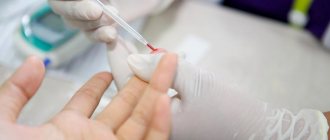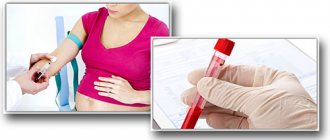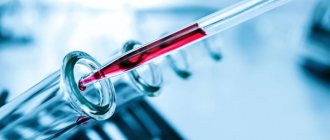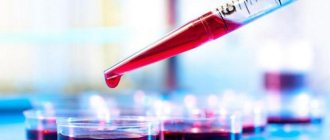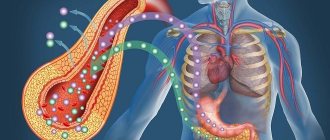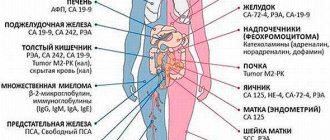What is genetic testing for disease susceptibility?
The structure and functioning of each organism is predetermined and embedded in the genetic code. This information, in the form of a chain of molecules, is tightly packed into 23 pairs of chromosomes and is contained in every cell of the body.
Under the influence of external factors, individual sections of the DNA molecule can undergo changes and mutate. This leads to “errors” in genes, as a result of which their regulation of processes in the body can be disrupted. In this form they will be passed on from generation to generation.
Changes in genes sooner or later manifest themselves in the form of pathologies. This may happen in one or several generations. There are a number of diseases that are genetically determined, for example, diabetes.
If there were previously cases of the disease in the family, then there is a possibility of its manifestation in subsequent generations. Genetic analysis will help detect a damaged gene or part of a chromosome.
This is a non-invasive method with a wide range of applications. The material for research is most often blood or saliva. After treatment with a contrast agent in the laboratory, the object is examined using a microscope. The area of DNA with suspected damage will be specifically stained, which will help geneticists identify the possible disease.
When is a genetic blood test performed?
The most common biomaterial for the test is venous blood. Any person interested in the information embedded in his genes, what diseases he has inherited or can pass on to his offspring can order a study. Medical indications for the study are:
- symptoms of a disease of unknown origin;
- the need to decide on a treatment regimen;
- searching for traces of bacterial DNA if a viral infection is suspected;
- determination of serious hereditary pathology so that, based on the results of the analysis, timely measures can be taken to prevent diseases;
- pregnancy after 35 years;
- the mother abuses alcohol during pregnancy, smokes, and has been exposed to x-rays;
- cases of stillbirth, frequent miscarriages;
- test for kinship and paternity.
For what hereditary diseases are there genetic tests?
More than 4,500 diseases can be detected using genetic tests. Among them are not only severe genetic syndromes, but also quite common diseases of internal organs and systems.
Genetic tests can detect not only current but also potential diseases, for example:
- mononucleosis;
- Down syndrome;
Genetic analysis for predisposition to diseases will allow early identification of Down syndrome
- stroke;
- diabetes;
- oncological diseases;
- thrombophilia;
- allergies, asthma;
- Alzheimer's disease;
- Crohn's disease;
- cystic fibrosis;
- alopecia;
- arterial hypertension;
- scleroderma;
- uterine fibroids;
- Gilbert's syndrome;
- sexually transmitted infections;
- adrenogenital syndrome.
For some diseases and syndromes, more than one test may be needed, since the mutation that causes it may be localized in different parts of the DNA.
Possible consequences of undergoing genetic diagnostics
Recently, the flow of publications and communications devoted to genetic research has sharply increased. Materials about them began to appear not only in specialized medical institutions, but also penetrated television and the press. It is often reported that a particular disease is associated with a specific gene or group of genes. We can talk about cancer, disorders in cardiovascular activity, deviations from normal physical or intellectual development and other problems. That's why people increasingly feel uneasy when they hear about genetic testing. This especially applies to issues of confidentiality, since if such information about the state of health is disseminated, a person may encounter difficulties and biased attitudes when applying for a job, conducting daily activities, and in his personal life. This discourages testing even from those who could benefit from it. In addition, in genetic diagnostics, as with any other form of medical testing, there remains a risk of error or misinterpretation of the result obtained. This is not least influenced by the high complexity of the analyzed data. In some cases, a mutation is discovered whose impact is currently unknown. However, developing technologies make it possible over time to clarify the results or verify the relative harmlessness of genotype changes.
Research groups
Genetic analysis for predisposition to diseases is carried out in two ways: karyotyping of chromosomes and isolation of DNA from the cell.
Cytogenetic analyzes
Changes in the human genome can be identified already at the chromosome level. Any deviation in quantitative or structural terms, as well as rearrangements from one pair to another, are established using cytogenetic research. The analysis is carried out using microscopy of cells that have been previously prepared and stained with reagents.
For research, venous blood is most often taken in a volume of 2 ml, but samples of any tissue and body media can be used. Chromosomes are viewed differently in different phases of the cell cycle. To assess their condition, cells are treated with antimetabolites to synchronize the cell cycle, then entered into the division phase.
At the second stage of division - prometaphase, both chromatids of each pair can be clearly observed, and at metaphase - chromosomes are discrete structures freely located in one plane. In the natural course of a cell’s life cycle, this phase lasts 2-3 minutes, so in the laboratory it is artificially prolonged.
At this stage, the chromosomes are subjected to differential staining. Depending on the nucleotide and protein composition, different parts of the chromatids will be colored differently. The result is compared with an existing database of chromosomal abnormalities, on the basis of which a diagnosis is made.
The analysis is carried out within 20-30 days from the moment the biomaterial arrives at the laboratory.
Molecular genetic tests
Unlike cytogenetic analysis, this method allows us to identify changes in the genome at the gene level, including the shortest ones.
In this way, it is possible to detect point mutations affecting individual nucleotide sequences of DNA that are not visible during microscopic visualization of chromosomes. Using molecular genetic analysis, deletions are also detected - the absence of individual sections in the chromosome. The research is carried out using various techniques.
The most popular of them:
- PCR, or polymerase chain reaction. With its help, it is possible to identify an insignificant number of atypical structures in DNA and RNA. To isolate the desired area, a genetic detector is used - a highly sensitive artificially synthesized DNA matrix, which serves as a reference. On its basis, the problem area is repeatedly copied. Once the sample has been expanded millions of times, it is visualized and analyzed based on the existing sequence.
The method has high sensitivity - 99% and specificity. Used to detect urogenital infections, hepatitis, HIV, borreliosis, encephalitis and many others. Effective even in cases where the disease has not had time to clinically manifest itself;
- FISH, or fluorescence hybridization method. The advantage of this method over others is the ability to study the genome directly in a biomaterial sample, without additional cultivation of molecules. The analysis can be carried out both in the division phase and in the interphase, when the chromosomes are completely untwisted and destructured.
The principle of the method is the introduction of a nucleotide sequence complementary to a specific DNA region. This affinity helps to find the desired damage with 100% accuracy, and a special fluorescent label on the introduced molecule makes it possible to detect attachment and identify a genomic defect;
- Microchipping. Unlike FISH, a fluorescent tag is placed on DNA, or RNA, isolated from the nucleus. After cloning, a specific section of the molecule is attached to a biological chip, which is a plate with ordered DNA or protein molecules. The advantage of the method is that it can be used to study the functionality of a large number of diagnostically significant genes in one sample.
The method is effective for determining infections of any nature, allergens, various biological substances, even in the most insignificant concentrations. Not applicable in Russia.
Test reliability
DNA testing is a highly accurate technique for studying the microcosm of an organism and the microprocesses in it. The test is deciphered based on the genetic base, which many world scientists and institutes are working to replenish. There are currently no more accurate diagnostic methods that offer different testing options.
Paternity: index
DNA paternity testing is one of the most famous studies in society, causing the greatest public outcry. The results of such research have legal force and are sufficient grounds for making a decision in court. What is the essence of testing?
Undoubtedly, many people know that the human DNA helix has a double structure. Thus, the child borrows part of the genotype from the mother, and part from the father. Comparing the alleles (different forms of the same gene) of the child and the father (and in some cases the mother) can confirm the probability of paternity with up to 99.99% accuracy. It is believed that a 100% result is not possible, since there is always the possibility of a potential father having twins. Paternity is 100% refuted.
The main indicator by which the relationship is calculated is called the “paternity index”. Without getting too technical, in general terms it is a measure of how similar the child's and potential father's alleles are in different areas of the gene code.
To standardize the results and eliminate possible errors in decoding the paternity test, the International Organization for Human Identification has established the following threshold values for determining paternity:
- 99.75 – 99.99% fully proven paternity
- 99 – 99.7% high probability of relationship
- 95 – 98.5 paternity is not excluded, but not proven
- 90 – 94.5 low probability of family connection
For kinship
In recent years, testing to determine nationality has become increasingly popular. And this is not only about people’s desire for self-identification: some need this to move to another country and obtain citizenship, while others want to restore their family tree and have an idea about their ancestors.
Often the results are surprising and have little in common with what the client imagined before receiving them. Sometimes the results of research are such that they can completely change a person’s attitude towards other nationalities, and expand the understanding of the deep interconnection between all people.
Also, testing can be carried out without the consent of the person being tested and the results can be provided to him as an original gift.
Congenital diseases
Timely testing for congenital diseases and predispositions to them can help you avoid many risks and prolong your life. Forewarned is forearmed. And this fully characterizes the usefulness of such an analysis. Today, specialists are able to identify up to 6,000 different viruses and infections, as well as determine genetic predisposition to the most dangerous diseases of our time.
When and to whom can a genetic blood test be prescribed?
Genetic analysis for predisposition to diseases will provide a detailed answer with 100% accuracy when clinical tests do not provide a complete picture of the patient’s health status.
It is prescribed in the following cases:
- when the disease has an unclear etiology, despite the use of basic diagnostic methods, and its course is complicated or atypical;
- when there is a risk of hereditary diseases. Genetic analysis will show not only the presence of a marker of a potential pathology, but also the percentage probability of its occurrence. There are diseases that are present in the genome, but do not manifest themselves due to their multifactorial nature - their activation requires certain conditions (an unhealthy lifestyle, abuse of harmful substances, radiation). Research is carried out for all age categories, including newborns from the first days of life;
- during pregnancy planning. Genome research will help identify the cause of infertility and spontaneous abortion when standard diagnostics have failed. Genetic analysis may be prescribed before IVF and other assisted reproductive technologies;
- as part of perinatal diagnostics. Already at the stage of intrauterine development, it is possible to diagnose the presence of genetic diseases in the unborn child, such as Down syndrome, Edwards syndrome and Patau syndrome, as well as heart and nervous system defects;
- to study the effects of medicinal substances. In cases where standard drug therapy causes an unusual reaction in the body, or does not lead to recovery, genetic analysis not only helps to identify the causes, but also to select the optimal drug for treatment.
What diseases can genetic testing detect?
Examination during pregnancy
Genetic testing during pregnancy allows you to detect complications arising in the fetus, perform karyotyping and prepare for pregnancy.
Karyotyping is a study of the number of chromosomes and the search for their structural abnormalities. For example, infertility can develop with monosomy or trisomy of the sex chromosomes, which cause the development of Shereshevsky-Turner disease and Klinefelter syndrome, respectively.
Photo: https://pixabay.com/photos/laboratory-analysis-diagnostics-2815632/
Women may have a genetic predisposition to miscarriage, which is caused by defects in various genes. Also, one of the common complications during pregnancy may be a tendency to form blood clots - thrombophilia. This pathology also occurs as a result of a genetic defect in certain enzymes.
Newborn examination
In newborns, genetic testing can detect chromosomal and gene mutations.
A mutation is a permanent change in the genome that can be inherited.
Chromosome disorders in children also include an increase or deficiency of chromosomes or their parts. For example, there are the most common trisomies, that is, instead of a pair of chromosomes there are three:
- Down syndrome – another chromosome is added to the 21st pair;
- Patau syndrome - trisomy 13;
- Edwards syndrome - another chromosome is added to the 18th pair, resulting in 3 chromosomes.
There are many gene mutations that are detected in childhood. The most common diseases caused by gene defects in children are:
- cystic fibrosis;
- phenylketonuria;
- adrenogenital syndrome;
- galactosemia;
- congenital hypothyroidism.
These 5 pathologies are determined at birth. They are included in the so-called neonatal screening. It is worth noting that these pathologies are diagnosed in a newborn not by genetic research, but by other simpler and faster methods.
But if a pathology is detected, then it is necessary to refer the patient for a genetic analysis, which is highly specific, that is, it will give an accurate answer.
Determination of paternity
Genetic research has also found its application in determining paternity. The genetic material of the parent and child is compared, then a conclusion is made as to whether the person is a parent or not.
How to prepare for donating blood?
Genetic analysis and its effectiveness depend not only on the qualifications of specialists, but also on the availability of high-quality equipment and reagents for assessing susceptibility to diseases.
Preparation for testing is essential, which includes:
- donating blood in the morning (no later than 10:00);
- last meal at least 2 hours before blood donation;
- absence of acute infectious diseases, except in cases prescribed by a doctor;
- avoiding alcohol intake, overeating and other significant changes in diet;
- stopping taking antibiotics at least a month before donating blood;
- temporary cessation of taking medications that may affect test results (the list is agreed with the attending physician).
What diseases can genetic testing diagnose?
There is a constantly growing list of monogenic diseases that have been linked to specific disorders in a single gene. As a rule, if there is a mutation in it, the disease will definitely develop. In some cases, it is impossible to estimate the time of onset of symptoms, severity, or rate of progression of the disease.
The group of polygenic diseases includes cases that are influenced by hereditary information and environmental factors, which include diet, lifestyle, addiction to bad habits, as well as unknown or insufficiently studied influences. In this case, the presence of a mutant gene makes a certain contribution to the likelihood of the disease occurring, but the disease itself may not develop. In most cases, the change (up or down) in risk by 5-10-15 percent depends on the genetic factor. For some diseases (particularly breast cancer), having the corresponding altered gene can increase the risk by up to 85 percent.
If you suspect an increased likelihood of a particular disease and if you wish to undergo an early presymptomatic genetic diagnosis procedure, you should seek advice from a competent specialist. Only a geneticist can provide the relevant information.
Genetic tests during pregnancy
Already in the first trimester of pregnancy, women undergo mandatory prenatal screening to assess fetal growth and development. It includes a biochemical blood test and ultrasound.
If the results of the initial diagnosis reveal deviations from the norm, a genetic test is prescribed to determine the presence in the blood of:
- free beta unit of human chorionic gonadotropin (hCG). Indications below normal may indicate existing anomalies, oligohydramnios, non-developing pregnancy and other abnormalities in fetal development;
- blood plasma protein associated with pregnancy - PAPP-A. Low readings at 8-14 weeks may indicate the development of diseases - Down syndrome, Patau syndrome, Edwards syndrome, or the threat of miscarriage.
In the second trimester of pregnancy, women are given a triple test.
For analysis, blood is taken from a vein and examined for the content of specific components associated with pregnancy:
- free beta unit of hCG;
- AFP - alpha fetoprotein. Serves as a marker for such developmental defects as the absence of the duodenum, abnormalities of the liver, kidneys, and brain;
- mE3 – unconjugated estriol. High rates may indicate malformation of the brain and cranial vault (anencephaly), chromosomal abnormalities, and developmental delay.
Screenings in the first and second trimesters are mandatory. The data obtained allow us to assess the risk of developing chromosomal diseases and make a timely decision on the advisability of continuing the pregnancy.
Genes know everything!
By studying the human genome, hundreds of serious diseases can be identified
The achievements of modern science make the possibilities of medicine almost limitless. Advances in the field of molecular genetic research, based on a detailed study of the human genome, the structure and function of DNA, make it possible to establish the causes of many diseases transmitted by inheritance. Identification and study of mutations and damage leading to structural and biochemical disorders in the human body make it possible to develop high-quality diagnostics and prevention of hereditary diseases. Our “Version” talks with Alexander Bonetsky, Candidate of Biological Sciences, Deputy Director of the Business Development Department of the INVITRO Independent Laboratory.
What are molecular genetic studies? What are they needed for?
Molecular genetic research includes a rather interesting and promising section of medical laboratory diagnostics. Their task is to identify individual genetic characteristics of a person, determined by gene variability (or polymorphism). Today we know that each person has about 35 thousand genes. For different people they are “almost similar,” but they have their own nuances that distinguish people from each other. In this regard, we can say that every person is unique, and his uniqueness is reflected in his genetic code. By examining the individuality of genes and identifying gene polymorphisms (genetic characteristics in different genes), we can assess the risk of disease for each person. Moreover, evaluate the contribution of any external factors (ecology, diet, lack of vitamins, etc.) to the likelihood of developing these diseases. The presence of certain combinations of gene variants can give a person unique inclinations or, on the contrary, under certain conditions lead to diseases. The available capabilities of molecular genetic research already make it possible to identify predisposition to many common diseases that depend on many factors and are called multifactorial: coronary heart disease, myocardial infarction, stroke, some forms of cancer and others with the aim of their effective prevention.
How long have similar studies been used in practice and what are their features?
It must be said that the study of certain sections of the DNA of various microorganisms has long become a fairly common analysis. This is what is called PCR tests in the medical community. Many had to give them up. But until recently, research into the human genome was only the prerogative of research centers, and only recently these studies began to be used for routine diagnostics. So molecular genetic research is a very young area of diagnostic research. In our country, such studies appeared only five years ago.
Who is recommended to undergo genetic testing?
First of all, these are persons among whose close relatives any multifactorial disease occurs more often than usual. These include cardiovascular diseases, cancer, and a fairly large number of reproductive disorders. If, as geneticists say, there is a family history of any disease, then it makes sense to undergo these examinations, which will allow us to assess the degree of risk of this disease and develop preventive measures specific to a given patient that will reduce this risk. Let me note that in this case we are not talking about making a diagnosis, but only about assessing the increase or decrease in the risk of some specific diseases.
How does molecular genetic research take place?
From the patient's point of view, the test appears fairly standard. A person comes to the treatment room, donates blood from a vein, and is given a date when the test will be ready. Blood for testing is taken in an amount of 5 ml. That's not a lot. The difference is that before taking blood, a preliminary consultation with a doctor is carried out. During this conversation, the doctor collects information that is necessary for the subsequent interpretation of the results. Remember, these are molecular genetic studies, so traditional genetic methods cannot be used here.
How is prevention carried out?
There are no bad genes, just bad habits. Prevention is connected precisely with the fact that multifactorial diseases are determined both by genetic factors associated with genes and environmental factors, which determine whether the potential inherent in genes is realized or not, and I will say, more importantly, in which direction - negative or positive it is being realized. For example, there is a variant of the gene encoding one of the lymphocyte proteins. Before humanity encountered AIDS, this option was rather viewed as negative, since in its carriers the hepatitis C infection occurs in a more malignant form. But it turned out that carriers of this seemingly “unsuccessful” variant turned out to be absolutely resistant to type 1 HIV infection. So, everything is relative. There are genes that are responsible for enzymes involved in the inactivation of various toxic substances, in particular substances contained in cigarette smoke. There are genetic variants in which these enzymes do not function in humans. This leads to the fact that toxic substances are poorly removed from the body, which threatens the development of cancer. If this particular person smokes, then his risk of getting lung cancer is very high. But, if the carrier of these genetic variants stays away from cigarette smoke since childhood, then the risk of getting sick for him will not be higher than the population average.
Are there any other precautions a person should take? In fact, there are a lot of different genes in the body that are associated with very different aspects of the body’s life. Gene polymorphism can cause an increased risk of a wide variety of diseases. Genetic variants are known to be associated with an increased risk of fetal malformations. But if a woman takes certain vitamins in preparation for pregnancy and during pregnancy, then this risk is practically leveled out, that is, it will not be higher than in women with completely normal genes. In each specific case, the situation may be individual.
What does this analysis provide if it is recommended by a doctor when the patient presents late, that is, when the disease has already progressed?
We are talking about multifactorial diseases; usually these diseases develop in adulthood. Conducting molecular genetic studies in cases where the disease has occurred can also provide useful information, since knowledge of genetic characteristics will allow you to adjust the patient’s lifestyle and correctly prescribe treatment.
What can molecular genetic research bring to domestic medicine with its further popularization among the population?
Molecular genetic research is primarily interesting from the point of view of preventive medicine. Here, a big role belongs to the education of culture among our people. There is no need to wait for the disease to occur if you can foresee it in advance and take certain measures. This is the main purpose of molecular genetic research. With the development of medicine, the role of this area of laboratory diagnostics will undoubtedly increase.
Genetic analysis in a newborn
Genetic analysis for predisposition to diseases is carried out as part of neonatal screening. This is a mandatory procedure approved by WHO for the purpose of early diagnosis of newborns. As a rule, it is carried out in the first 10 days after the birth of the child: on the 3-4th day in full-term infants and on the 7th day in premature infants.
Blood sampling is carried out in the maternity ward, or at home if the mother and child have already been discharged. To do this, the nurse makes a light puncture on the baby's heel and applies a few drops of the blood that appears on a special form. The sealed sample is sent to the laboratory, where the result will be ready within 10-14 days.
Despite the possibility of diagnosing more than 50 genetic diseases, screening is carried out to identify five of them:
- phenylketonuria;
- cystic fibrosis;
- androgenital syndrome;
- hypothyroidism;
- galactosemia.
These diseases can be treated if diagnosed early, so they are included in the mandatory list. If parents wish, the range of research can be expanded.
What is the essence of genetic testing (genetic diagnostics)?
The main objective of molecular genetic research is to identify mutations (that is, alternative variants in the genotype, polymorphisms) that can become an internal cause for the appearance of a monogenic or multifactorial (polygenic) disease.
The detection of mutant genes responsible for monogenic diseases makes it possible to diagnose the corresponding disease given the existing clinical symptoms characteristic of a particular case. Gene polymorphisms are studied when it is necessary to identify hereditary factors that influence susceptibility to polygenic diseases in order to take effective preventive measures. Also, conducting a test allows you to assess the likelihood of the disease occurring in children if the parents are carriers of certain genetic abnormalities. As a rule, genetic diagnosis or genetic testing refers to the analysis of DNA (in some cases RNA or a protein corresponding to DNA), and the gene that is associated with the occurrence of a specific disease is tested. Such a test can provide information about the likelihood of developing a certain disease in later life. For example, if cases of a recurring disease have been found in a family for several generations, or there are indications of this in the pedigree, and the gene that could cause the development is known, then you can contact a genetic counselor. Pre-symptomatic diagnosis in this case makes it possible to accurately determine whether the gene is inherited.
Reasonable reasons to undergo genetic testing include the following:
· There are effective methods for preventing the disease or the accompanying symptoms can be successfully treated;
· The disease cannot be treated and cannot be prevented, but information about it is important for making a decision about conception;
· The disease cannot be prevented or treated, but the test results allow us to assess the risk for children;
· Knowledge of the likelihood of developing a disease can have a serious impact on certain decisions, including the timely initiation of treatment;
· There is a desire to know more about the characteristics of your body in order to have some confidence in the future.
How long does it take to study a sample?
The timing of genetic research depends on the type of biomaterial, the method of its collection and the method of analysis. Molecular genetic studies take 7-10 days from the moment the material arrives at the laboratory, and the duration of analysis using the FISH method is from 3 to 14 days, depending on the purpose. Cytogenetic studies take on average from 10 to 23 days.
The material is collected directly in the clinic or at home. To do this, the medical center to which you apply for the service sends by mail a special sterile container for collecting the material. In this way, you can send saliva, blood and other types of biomaterials. In such cases, the waiting time for results increases due to delivery times.
Indications for analysis
A genetic test is mandatory if a pregnant woman is included in the risk group:
- the expectant mother is over 35 years of age;
- the expectant mother has already given birth to children with congenital anomalies or deviations;
- in a previous pregnancy the woman suffered dangerous infections;
- the presence of a long period of alcohol or drug addiction before the onset of fertilization;
- the presence of cases of spontaneous miscarriage or stillbirth.
Decoding the results
Genetic analysis for predisposition to diseases ends with deciphering the data obtained. This is the most labor-intensive process, which is carried out on expensive electronic equipment.
Only a few city institutions can afford such equipment, mainly private clinics and medical centers. You can contact them directly or through online services.
Is it possible to influence the result?
Even theoretically, falsifying DNA analysis results is very, very difficult. If we assume that someone managed to bribe a laboratory employee, then such a substitution can only be made in collusion with all the study participants - the entire analysis procedure is documented and photographed, and is carried out under the supervision of an authorized person.
If you still suspect that the analysis results are unreliable, you can always request a repeat test in the same or another laboratory. If the substitution of results is confirmed, the perpetrators will not only bear criminal liability, but will also have to compensate for all costs associated with the verification.
In the most incredible scenario, Israeli scientists are testing a method for synthesizing an artificial DNA chain, but this is not yet a ready-made and very expensive technology. And to use it, you need to have access to a bank of all the studied genes, which a regular medical institution does not have.
In this regard, and due to the high accuracy of DNA research results, testing is the only way to prove paternity, or lack thereof, in court. At the moment, the state does not provide a free opportunity to conduct a paternity test, but in cases where, during legal proceedings, the court itself decided on the need for research, its payment is included in the legal costs and is covered from the regional budget.
Price
Depending on the complexity of the analysis, the price of a genetic study will vary from 500 rubles. and higher. In private laboratories, the average cost of analysis for one disease is 2-5 thousand rubles. There are companies that provide comprehensive genome diagnostics in several areas at once:
| Company name | Directions in testing | Where is | price, rub. |
| Genotek |
| Russia Moscow | one analysis – from 20 thousand, complete decoding of the genome – 375 thousand. |
| My gene |
| Russia, Yekaterinburg | one analysis – from 30 thousand. |
| Atlas |
| Russia Moscow | analysis in all areas – 30 thousand. |
| Lifegen |
| USA, with representative office in Russia | 30 000 – 70 000 |
| MyGenetics |
| Novosibirsk, Russia | from 4900 to 30 000 |
| yRisk | predisposition to hereditary forms of cancer | Russia Moscow | 35 000 |
| 23andMe |
| USA | 199$ |
Researching the human genome is a labor-intensive and often expensive process, but it is completely worth it. Genetic testing is used to assess susceptibility to disease, sensitivity to medications, and identify potential causes of unusual body responses.
Research Features
As we said above, a DNA test is something that only needs to be done once. Its results will always be relevant, and the recommendations received can be used for decades.
Thus, MyGenetics DNA analysis technologies are based on international research from Stanford University, data from NCBI (USA) and the European research consortium Food4Me.
Genes and their influence on the body
ADRB2 gene
This gene encodes a protein that, when in contact with adrenaline, can increase the rate of breakdown of sugars in tissues. In addition, it affects a person’s athletic potential—this gene can be used to determine factors in the development of endurance.
TCF7L2 gene
The gene encodes a protein that is involved in the formation of pancreatic beta cells - they, in turn, take part in the secretion of insulin, which is necessary to reduce blood glucose levels. A less favorable variant of the gene disrupts insulin production in response to increased blood glucose levels. This increases the risk of developing type 2 diabetes. Therefore, it is important to know which gene variant you have. This is how you can determine whether you are predisposed to developing diabetes.
FTO
The FTO gene is called the “obesity gene.” Those with an unfavorable variant of this gene have a 1.7 times higher risk of obesity compared to other people. According to experts, the FTO gene increases cravings for high-calorie foods and reduces the feeling of fullness after eating. Therefore, it is extremely important to know whether a person is a carrier of this gene and, accordingly, whether he has a predisposition to gaining excess weight. This information will help you create the right diet and determine the optimal level of physical activity for a particular person.
The FTO gene encodes a protein that regulates the production of satiety hormones and thereby affects the amount of food consumed. Polymorphism in this gene is associated with a delayed feeling of satiety and an increase in the amount of food consumed.
FABP2
Otherwise, the FABP2 gene is called the fatty acid transporter gene. This gene encodes a protein that binds fatty acids in the intestine and is responsible for their uptake, transport and metabolism. An unfavorable gene variant leads to increased digestibility of saturated fatty acids in the intestines and excess weight gain.
PPARG
The PPARG gene encodes a protein involved in the utilization of fatty acids and glucose in muscle and adipose tissue. One form of the gene helps increase the rate of nutrient utilization. In addition, this gene affects the effectiveness of fasting days - a special mono-diet lasting 1-2 days, when a person gives his body a “rest” from the usual diet.
High risk group
There is a certain category of women for whom mandatory genetic consultation is indicated:
- The expectant mother is under 18 years of age or over 35 years of age.
- The presence of hereditary diseases.
- Women who gave birth to a child with developmental anomalies.
- Having in the past or present any type of addiction - alcohol, drugs, tobacco.
- Couples suffering from dangerous infections - HIV, hepatitis, pregnant women who have had rubella, chickenpox, herpes in the early stages of gestation.
- An expectant mother who has taken medications that are undesirable for use while pregnant.
- Those who received a dose of radiation at the beginning of gestation due to fluorography or x-ray examination.
- Women who were involved in extreme sports in their youth.
- Expectant mothers who have taken a high dose of UV radiation.
Sometimes a woman does not know about the conception that has occurred, being exposed to unfavorable factors. Therefore, many pregnant women are at risk of falling into the risk group.
Molecular genetic tests at Top Ichilov
Thanks to their use, the clinic’s oncologists are able to:
- Detect cancer of any kind at the earliest stage
- Obtain the most accurate information about the tumor, determine its strengths and weaknesses, resistance to some drugs and reaction to others
- Predict the effect of various forms of therapy on the tumor
- Predict the likelihood of relapse as accurately as possible
As a result, Top Ichilov specialists develop a truly individual treatment program that takes into account all the characteristics of the tumor and the patient’s body.
In 92% of cases, Top Ichilov experts offer the patient a diagnostic or treatment program that is at least 20% cheaper than the offer of any other clinic in Israel!
Programming is free
How genetic analysis is done - research methods
A geneticist studies in detail the pedigree of future parents and assesses the risk of hereditary diseases. The specialist takes into account the professional sphere, environmental conditions, and the influence of medications taken shortly before the visit to the doctor.
The doctor conducts a karyotype study, which is necessary for an expectant mother with a complicated medical history. It makes it possible to analyze the qualitative and quantitative chromosomal composition of a woman. If the parents are close blood relatives or there has been a miscarriage, HLA typing is necessary.
The geneticist conducts non-invasive methods for diagnosing congenital anomalies of fetal development - ultrasound and tests for biochemical markers.
The latter include:
- determination of hCG content;
- blood test for PAPP-A.
The American company has patented 1 more test. At week 9, the expectant mother donates venous blood, which contains hereditary information - the child’s DNA. Specialists count the number of chromosomes, and if pathology is present, a number of syndromes are identified - Down, Edwards, Patau, Turner, Angelman.
If non-invasive tests reveal abnormalities, the specialist performs an invasive examination. With their help, material is collected and the baby’s karyotype is determined with high accuracy to exclude hereditary pathologies - Down syndrome, Edward syndrome.
These methods include:
- Chorionic villus biopsy. The doctor punctures the anterior abdominal wall and then takes cells from the developing placenta.
- Amniocentesis . They take a puncture of amniotic fluid, evaluate its color, transparency, cellular and biochemical composition, volume, and hormone levels. The procedure is considered the safest of the invasive diagnostic methods, but requires a lot of time to obtain a conclusion. The examination reveals abnormalities that appeared during pregnancy and assesses the level of fetal development.
- Cordocentesis. The study consists of performing an umbilical cord puncture and drawing the baby's blood. The method is accurate and the results are known within a few days.
- Placentocentesis . Placental cells are analyzed.
As a result of the tests, the specialist makes a genetic prognosis for the parents. Based on it, you can predict the likelihood of congenital pathologies and hereditary diseases in the baby. The doctor develops recommendations to help plan a normal pregnancy, and if conception has already occurred, determines whether it is worth preserving it.
Genetics accessible to people
Genetic studies are those types of modern laboratory diagnostics that are fully associated with the concept of “middle class”. People belonging to this class try to be healthy, prevent diseases rather than treat them, being committed to the principles of a healthy lifestyle, and tend to seek success in life, adhering to universal European values. Therefore, the stronger a small and medium-sized business is, the more widespread modern genetic research is.
Genetic research, especially in the field of pharmacogenetics, nutrigenetics, assessment of multifactorial and single risks for the development of various diseases, completely coincides in values with the middle class: it is better to prevent than to treat. At the same time, the collection of biomaterial is carried out very quickly, which saves time: you don’t even need to take blood, you just need to scrape the oral mucosa with a stick, and thereby obtain the hereditary material for analysis.
Genetic tests have two small “disadvantages”: cost and duration of the analysis.
Thus, the average cost of chromosomal microarray analysis and determination of inheritance is about 500 US dollars, and genome or exome research ranges from 70 to 80 thousand rubles per patient. One of the cheapest methods of genetic analysis is karyotype research, and, on average, in private laboratories it can be performed for 6,000 rubles. The duration of the study is also much longer than with conventional biochemical blood sampling, examination of the patient’s urine, feces or hormonal levels. After all, sometimes you need to decipher the sequence of millions of nucleotide pairs, and it is not surprising that the analysis sometimes takes two weeks to prepare, and sometimes even a month.
What does the analysis show?
Genetic tests show which genes have changes that are associated with an increased risk of cancer. There are two groups of genes in which such mutations can occur.
Proto-oncogenes encode proteins that activate cell division. Normally, they should “turn on” only at a certain time. If a proto-oncogene becomes mutated or becomes overactive (for example, due to increased copy number), it becomes an oncogene and the normal cell becomes a tumor cell.
Common examples of oncogenes are EGFR and HER2. These receptor proteins are embedded in the cell membrane. When activated, they trigger a chain of biochemical reactions, as a result of which the cell begins to actively, uncontrollably multiply. All mutations in proto-oncogenes are acquired and are not inherited.
Tumor suppressor genes limit cell reproduction, repair damaged DNA, and are responsible for the “death” of spent cells. Cancer occurs due to the fact that, as a result of mutations, these genes cease to cope with their function. For example, the BRCA1 and BRCA2 genes are responsible for DNA repair. With hereditary mutations in them, women have an increased risk of being diagnosed with breast and ovarian cancer.
The European clinic cooperates with leading foreign laboratories. They use modern sequencing technologies that help quickly study human DNA and identify changes in hundreds of genes:
- replacement of bases - “letters” of the genetic code;
- deletions - loss of a section of a chromosome;
- insertions - “extra” DNA inserts in chromosomes;
- change in the copy number of a specific gene;
- fusion mutations - the fusion of genes, as a result of which a new, hybrid gene is formed;
- microsatellite instability;
- mutational load of the tumor.
